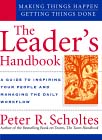The Leader's Handbook
by Peter R. Scholtes
Order the Leader's Handbook now Read reviews of the Leader's Handbook
In an age of increasing complexity, too many leaders resort to simplistic approaches. The Leader's Handbook proposes relatively simple approaches that, however, are not simplistic.
Understanding the new methods requires several new competencies:
- Systems Thinking: Helping people to understand the larger contexts of work. To fail to understand systems is to disregard the complexity of work and thus put in place simplistic - and unsuccessful - methods. This is a major theme in The Leader's Handbook.
- Statistical Thinking: The intelligent use of data is how we can understand our systems, predict future performance, plan, select priorities and solve problems. Without data we see trends where there are none, miss real trends and give credit or blame to people for results that are truly beyond their control. Statistical thinking is another central theme of The Leader's Handbook.
- Understanding Human Behavior: We are simplistic about people: we look for heroes to reward or culprits to punish. We believe we know how to motivate people when we cannot. We create elaborate incentive plans that not only don't work but make things worse. This book looks more deeply into people's behavior and such issues as trust, resistance to change, motivation and culture.
- Understanding Learning and Improvement: How do we know that a proposed change will result in improvement? Simplistic approaches seldom ask the question, neither before nor after the change is introduced. If leadership is prediction - and it is - how must leaders learn what is necessary in order to make predictions that are more than guesswork? In The Leader's Handbook you will learn approaches to learning and forecasting that are reasonably simple and never simplistic.
- Understanding Interactions: Performance is what results from the interaction of various events and factors. Leadership requires an understanding of these interactions. The Leader's Handbook will help leaders see how the understanding of systems, statistical thinking, learning and human behavior influence each other and together shape and affect how leaders lead.
- Giving the Organization Direction and Focus: Simplistic leadership seeks to direct and control people. The Leader's Handbook will help leaders learn to give direction and focus to the organization while working with people to control the flow of work. Leaders will learn how to give direction and focus to daily work as well as to annual and long term plans.
The Leader's Handbook weaves together a holistic and integrated philosophy of leadership as well as several practical tools and approaches. Each chapter includes questions and activities for those who want to integrate the message of this book into their thinking and activities, thoughtful leaders from many types of organizations will find useful insights and guidance.

